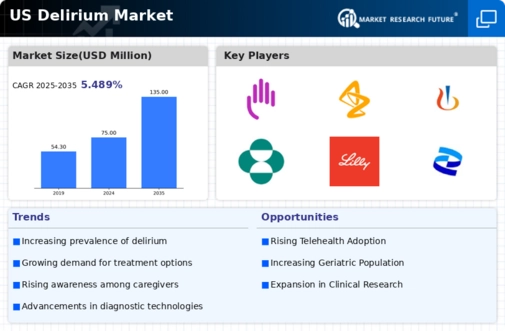Increased Research Funding
The surge in research funding dedicated to understanding and treating delirium is a significant driver for the delirium market market. Government and private institutions are allocating substantial resources to investigate the underlying mechanisms of delirium and its long-term effects. For instance, the National Institutes of Health (NIH) has increased its funding for delirium-related research, which has seen a rise of over 20% in recent years. This influx of financial support is likely to foster innovation in treatment modalities and diagnostic tools, thereby enhancing the overall market landscape. As new findings emerge, they may lead to the development of targeted therapies, further propelling the growth of the delirium market market.
Rising Incidence of Delirium
The increasing incidence of delirium among hospitalized patients is a critical driver for the delirium market market. Studies indicate that approximately 30% of hospitalized patients experience delirium, particularly among the elderly population. This rise in cases necessitates enhanced diagnostic tools and treatment options, thereby expanding the market. The aging population in the US, projected to reach 73 million by 2030, further exacerbates this issue. As healthcare providers become more aware of the prevalence and impact of delirium, there is a growing demand for effective management strategies. Consequently, this trend is likely to stimulate growth in the delirium market market, as stakeholders seek innovative solutions to address the needs of this vulnerable patient demographic.
Integration of Digital Health Solutions
The integration of digital health solutions into delirium management represents a transformative driver for the delirium market market. Telehealth platforms and mobile applications are increasingly being utilized to monitor patients at risk of delirium, providing real-time data to healthcare providers. This trend is particularly relevant in the context of an aging population, where remote monitoring can enhance patient care and reduce hospital readmissions. The digital health market is projected to grow significantly, with estimates suggesting a compound annual growth rate (CAGR) of over 25% in the coming years. As these technologies become more prevalent, they are likely to reshape the landscape of the delirium market market, offering innovative ways to manage and prevent delirium.
Regulatory Support for Delirium Management
Regulatory bodies in the US are increasingly emphasizing the importance of delirium management, which acts as a catalyst for the delirium market market. Initiatives aimed at improving patient safety and quality of care have led to the establishment of guidelines that encourage the identification and treatment of delirium. For example, the Centers for Medicare & Medicaid Services (CMS) has introduced measures that incentivize hospitals to implement delirium screening protocols. This regulatory support is likely to drive the adoption of new technologies and treatment options, as healthcare providers seek to comply with these standards. Consequently, the delirium market market may experience accelerated growth as stakeholders respond to these regulatory changes.
Growing Demand for Non-Pharmacological Interventions
There is a notable shift towards non-pharmacological interventions in the management of delirium, which serves as a key driver for the delirium market market. Healthcare providers are increasingly recognizing the importance of holistic approaches, such as cognitive stimulation and environmental modifications, in preventing and managing delirium. This trend is supported by evidence suggesting that non-pharmacological strategies can reduce the incidence of delirium by up to 50%. As hospitals and care facilities adopt these practices, the demand for related products and services is expected to rise. This shift not only enhances patient outcomes but also creates new opportunities within the delirium market market for innovative solutions that align with these evolving care paradigms.























Leave a Comment